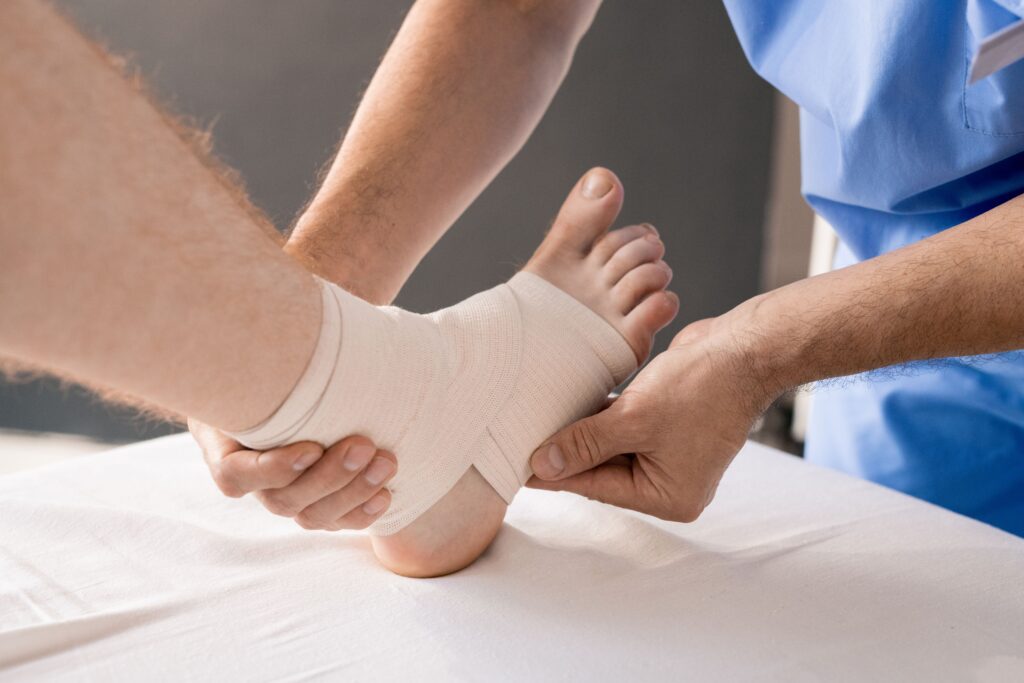More Than “Just a Twist”
Ankle sprains happen when the ligaments that hold the ankle bones together are stretched or torn. This usually occurs when the foot rolls inwards or outwards suddenly, such as during sports, uneven walking, or even a simple misstep on the stairs.
or inflamed. This tissue supports the arch of the foot, and repeated strain can cause tiny tears, leading to pain and stiffness.
Although ankle sprains are very common, they should not be taken lightly. Without proper care, a seemingly small sprain can lead to long-term instability and recurring injuries.
What Does an Ankle Sprain Feel Like?
Typical symptoms include:
- Pain immediately after the injury
- Swelling around the ankle joint
- Bruising or skin discolouration
- Difficulty standing or walking on the affected foot
- A feeling of “weakness” or instability in the ankle
The severity can range from a mild stretch of the ligament to a complete tear. In some cases, what seems like a sprain may actually be a fracture.
How Do Sprains Happen?
Ankle sprains are often caused by:
- Sudden twists while running, jumping, or landing
- Uneven ground or stepping on another person’s foot during sports
- Wearing unstable footwear, such as high heels
- Previous ankle injuries that weaken the ligaments
- Poor balance or weak muscles around the ankle
Getting the Right Diagnosis
A doctor will examine the ankle to check swelling, tenderness, and stability. In mild cases, this may be enough for diagnosis. For more serious injuries, X-rays may be done to rule out a fracture. In some cases, an MRI is ordered to assess the extent of ligament damage.
Treatment: From First Aid to Recovery
The treatment plan depends on how severe the sprain is. Common approaches include:
Initial Care (R.I.C.E.)
- Rest: Avoid activities that put stress on the ankle
- Ice: Apply cold packs to reduce swelling
- Compression: Use elastic bandages or ankle supports
- Elevation: Raise the foot above heart level to reduce swelling
Medications
- Pain relief or anti-inflammatory medicines may be prescribed to ease discomfort
Physiotherapy and Rehabilitation
- Gentle range-of-motion exercises to restore flexibility
- Balance and strengthening programmes to reduce risk of future sprains
- Use of braces or supports during sports or recovery
Injections or Procedures
- In certain cases, injections may be considered for persistent swelling or pain
Surgery
- Rarely required, but may be recommended if ligaments are severely torn or if repeated ankle sprains lead to chronic instability
Bouncing Back Safely
With proper treatment, most ankle sprains heal within weeks. However, recovery time varies depending on the grade of injury:
- Mild sprains: Usually recover within 2–4 weeks
- Moderate sprains: May take 6–8 weeks
- Severe sprains: Can take several months and may need surgical repair
To prevent future sprains:
- Strengthen ankle and leg muscles
- Wear supportive footwear during sports and exercise
- Warm up before physical activity
- Use ankle braces or supports if you have a history of sprains
When to See a Doctor
Seek medical attention if:
- You cannot put weight on your ankle
- The ankle looks deformed or extremely swollen
- Pain does not improve after a few days of home care
- You experience repeated sprains in the same ankle
Early evaluation ensures that fractures or serious ligament injuries are not overlooked.
Regain Stability with Personalised Care
If you’ve twisted your ankle and the pain lingers, don’t brush it off as “just a sprain.” Our team at Mash Spine & Orthopaedics can provide a thorough assessment and treatment plan tailored to your injury.
- Farrer Park Medical Centre, 1 Farrer Park Station Road, #07-14 Connexion, Singapore 217562
- Call +65 6518 9545
- Book your Appointment Today
Ankle Sprain Treatment – At a Glance
What it is:
- Ligament injury caused by twisting or rolling the ankle
Key Symptoms:
- Pain, swelling, and bruising around the ankle
- Difficulty walking or standing
- Instability or “giving way” of the ankle
Who’s at risk:
- Athletes in running/jumping sports
- People with previous ankle sprains
- Wearing high heels or unstable shoes
Treatment Options:
- R.I.C.E. (Rest, Ice, Compression, Elevation)
- Pain relief medication
- Physiotherapy and strengthening
- Braces or supports
- Surgery for severe tears or chronic instability





